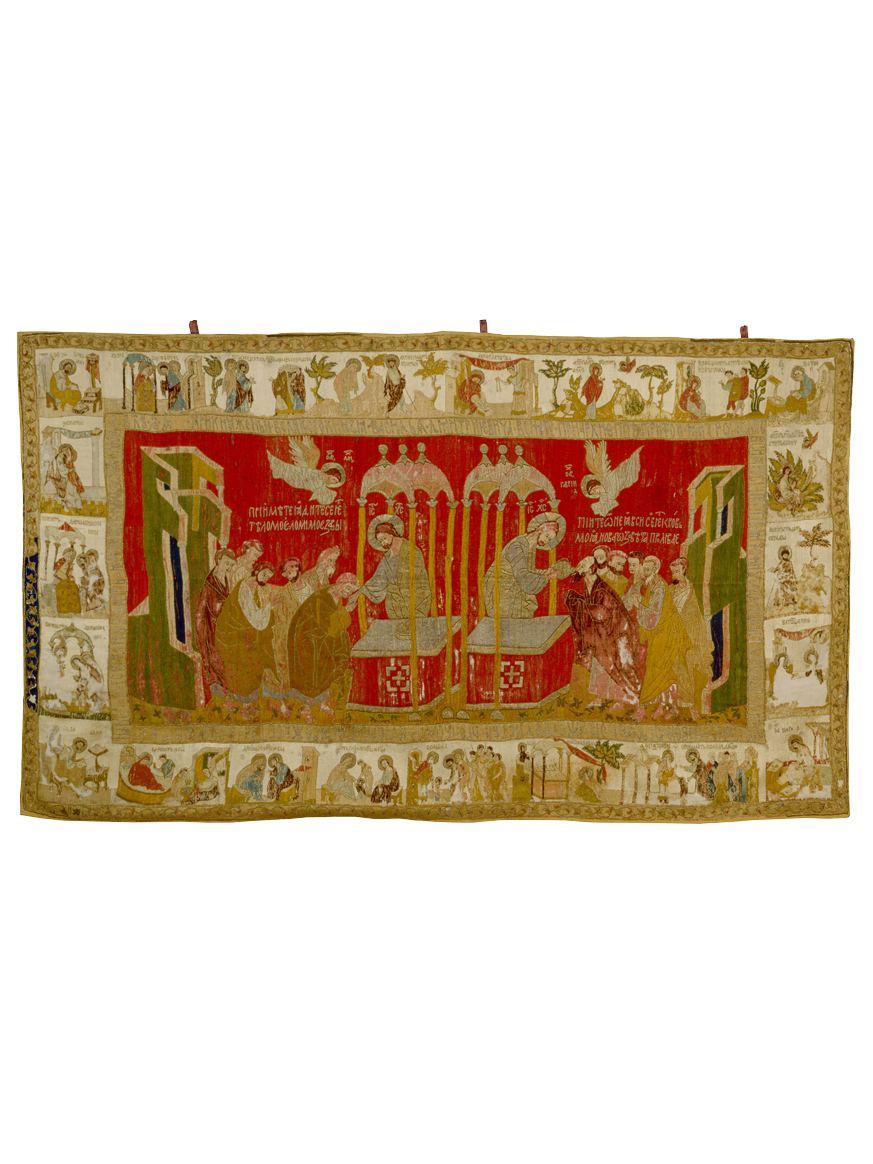Altar-cloth "Eucharist with hagiographies of God Mother, Ioakim and Anne”

“Suzdal air”, as the hanging veil with the image of a double oblation (sacrament of the Eucharist) is usually called, is one of the outstanding works of Old Russian embroidery of the first quarter of the 15th century. The altar-cloth was made for the Church of the Nativity of Our Lady of Suzdal. Apparently, this is the contribution of the unknown Ogrofena Konstantinova to the church with a prayer for the birth of a child, since it depicts in the middle (centerpiece) a scene of Christ’s communion of the apostles, and on the border - evangelists and scenes of life of Our Lady, Joachim and Anna. The icon painter, whose painting was used to make embroidery of the “air”, was close to the school of Andrei Rublev, what is evidenced by a number of signs in the interpretation of individual details and the way the central composition is made.
"Eucharist" (Greek “grace”) – is the most important part of a Christian worship - the liturgy, during which the rite of the sacrament of communion is performed.
Among various types of Old Russian art, pieces of "facial" sewing, which had much in common with painting, were highly valued in Russia. Among them were so-called “airs” and altar-clothes for decorating temples, shrouds and gonfalons for celebration ceremonies, embroidered icons and even iconostasis used during military campaigns. They were carefully kept in sacristies of monasteries and in rich houses, carefully preserving and passing from generation to generation. In the creation of these works took part a variety of craftsman. An image for embroidery was usually maid by an icon painter, inscriptions were made by a “word-writer”, and the patterns were drawn by etchers. Faces and naked parts of the body were embroidered with silk of a skin or gray tone with a satin stitch (stitches fit snugly together), or a “split” stitch, when the needle is pierced into the middle of previous stitches splitting them. Clothing, landscape, architecture were embroidered with either colored silk, or with silver and gold threads “in the attachment” (golden threads were overlaid on top of the fabric in parallel rows and sewn with colored silk). On many works there are supplementary chronicles (inscriptions) that brought to us information about the date of creation of the work, customers, workshop - princely, boyar or monastic, from which it came out.
Among the remarkable works of ancient Russian embroidery is a hanging altar-cloth with the image of the double oblation “Eucharist with hagiographies of God Mother, Ioakim and Anne”.
"Eucharist" (Greek “grace”) is the most important part of a Christian worship - the liturgy, during which the rite of the sacrament of communion is performed. The most common composition of the Eucharist in Old Russian art is two repeating scenes depicting Christ standing near the throne and serving the apostles with wine in one scene and bread in another. Bread and wine are symbols of body and blood of Christ. Sometimes standing or flying angels were added to the figures of Christ and the apostles.
In the centerpiece of the “Suzdal air”, as the altar-cloth is usually called, on the crimson background a symmetrical scene of Christ’s communion of apostles with archangels Michael and Gabriel flying to thrones is embroidered with multicolored silks. In the center of the composition is a double image of Christ standing before the church altar, above him a light vaulted canopy on five columns is. On the left apostle Peter with five apostles are coming to Christ. On the top there is an inscription in gold: “Take it, this is my body aching for you.” On the right Christ gives a vessel with wine to apostle Paul, who is followed by a group of five apostles too. Above them the inscription is made: "Drink from it, it is my blood of the new testament poured…”
A contribution chronicle around the centerpiece says that the “air” was created by the “servant of God Constantine’s Ogrofena” for the Suzdal Cathedral of the Nativity of Our Lady in the reign of Grand Duke Vasily Dmitrievich (1389–1425), with Metropolitan Photiy (came to Moscow in 1410–1431) and the bishop of Vladimir and Suzdal Mitrofan (1406–1416?). The inscription made with golden threads separates the centerpiece from border scenes with evangelists (in corners) and eighteen scenes of lives of Our Lady, Joachim and Anna:
1. Returning the gifts; 2. The opprobrium of barrenness; 3. Joachim's departure to the desert; 4. Crying Anna; 5. The Annunciation to Anna; 6. Announcement to Anne about the coming of Akim; 7. The Annunciation to Joakim; 8. The return of Joachim; 9. Conception; 10. Acceptance of the gifts of Joachim and Anna; 11. Blessing them by a priest; 12. Nativity of the Virgin; 13. “Nursing”; 14. First steps of the Virgin; 15. Entry into the temple; 16. Prayer of rods; 17. Presentation of Mary to Joseph; 18. The Annunciation.
Apparently, the altar-cloth was the contribution of an unknown Ogrofena Konstantinova to the church with a prayer for the birth of a child, since it depicts scenes of life of Our Lady, Joachim and Anna.
The icon painter, whose painting was used to make embroidery of the “air”, was close to the school of Andrei Rublev, what is evidenced by a number of signs in the interpretation of individual details and the way the central composition is made.
“Suzdal air” is one of outstanding works of Moscow art of the first quarter of the XV century.
